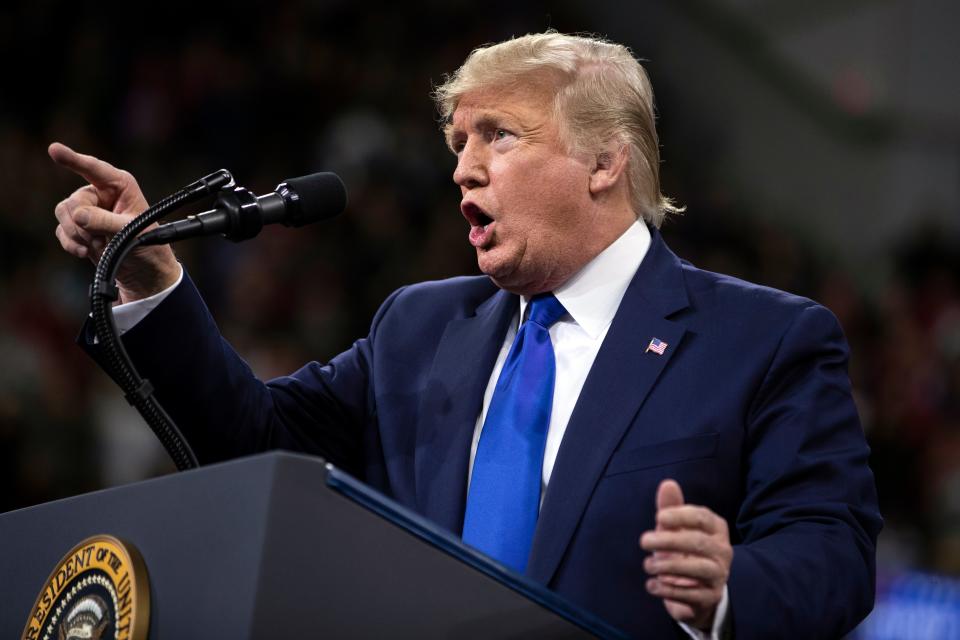What's in Trump's 'Phase One' trade deal between the U.S. and China?
WASHINGTON – After years of escalating trade tensions, U.S. and Chinese officials signed an initial deal Wednesday that calls on Beijing to buy more American products and takes a stab at addressing trade conflicts between the world's two largest economies.
The "Phase One" agreement, which President Donald Trump and Chinese Vice Premier Liu He signed at the White House, signaled a pause in the trade war and gave Trump a chance to claim victory months from the November presidential election.
White House officials released a 94-page agreement that details which U.S. industries China will buy from and potential changes it will make to address global concerns about intellectual property theft and other controversial trade practices.
Here's a look at some of the details in the agreement:
$200 billion in imports
The Trump administration had previously announced that China would boost its purchase of American goods and services by $200 billion over the next two years. The agreement provides some additional detail about where those purchases will be made. About $77 billion of those purchases will come from manufactured goods (cars, airplanes, medical instruments) while $32 billion would come from agricultural products.
The energy sector, including liquefied natural gas and crude oil, would represent another $52.4 billion, according to the agreement. The International Energy Agency has predicted that China will be the world's largest customer for liquefied natural gas in the next five year.
Deal signed: U.S., China sign 'Phase One' trade deal, signaling pause in trade war
Tariffs coming down
Trump had previously announced that the U.S. was lowering tariffs – and the threat of tariffs – as part of the agreement. Trump shelved plans to impose new tariffs on $160 billion of Chinese goods, including smartphones, electronics and other products that had been expected to take effect on Dec. 15. The Trump administration also previously cut the tariff to 7.5% from 15% on another $120 billion in Chinese products.
What does it mean for consumers? Effects of China tariffs on jobs, pricier good may linger
Opening agriculture markets
The deal lowers non-tariff trade barriers imposed on several agricultural sectors, including for dairy, beef and poultry farmers. For instance, China blocked U.S. poultry in 2015 after an outbreak of avian flu and maintained that ban until November of last year – long after the outbreak was over. The agreement would allow for the importation of those goods in part by requiring China to recognize U.S. Department of Agriculture Food Safety and Inspection Service inspections.
Trade secrets
The agreement requires China to impose "criminal procedures and penalties" to address "willful trade secret" theft, an issue that has been central to the trade war. Western companies have long complained that Beijing requires disclosure of technological secrets and then uses that information to aid Chinese-based competitors. The Trump administration had sought penalties for that practice. While the agreement requires China to impose penalties, it's short on specifics about their size and application.
The agreement also prohibits China from exerting pressure "formally or informally" on a company to disclose technology as a condition of securing a license or market access.
Opening financial markets
China will lift regulations on U.S.-owned financial firms, including securities and insurance companies, later this year. Lifting those restrictions should allow U.S. companies greater access to China’s financial markets. The agreement also calls on China to create an “improved and timely licensing process” to allow U.S. companies to sell their services in China’s growing electronic payment sector. Trump administration officials say that China has previously used the regulations to block U.S. financial companies from entering the market.
How will the deal be enforced?
The agreement includes language that could offer China opportunities to wiggle out of its commitments. For instance, in the section dealing with increased imports of U.S. goods, the agreement says that if China fails to meet the terms it would trigger only "the consultations" between the U.S. and China. In other sections, the agreement calls on China to change its practices without offering concrete targets for doing so.
White House officials said the agreement includes a new enforcement mechanism in which U.S. and Chinese negotiators must meet for consultations before retaliating or lodging a complaint with the World Trade Organization. The agreement allows for 90 days to resolve a dispute before taking either action.
In his remarks before signing the agreement, Trump described the provisions as having "total and full enforceability."
But it's not clear, based on the text of the agreement, how both sides will monitor those commitments and enforce them. Because the agreement breaks down the trade commitments over the calendar year, and because trade can be dependent on seasonal factors, it will make it impossible to assess whether the goals are being met before the U.S. election, said Phil Levy, a former White House official who is now chief economist of Flexport, a company that arranges and finances trade between 109 countries.

This article originally appeared on USA TODAY: Trump trade agreement with China: What's in the Phase One agreement

